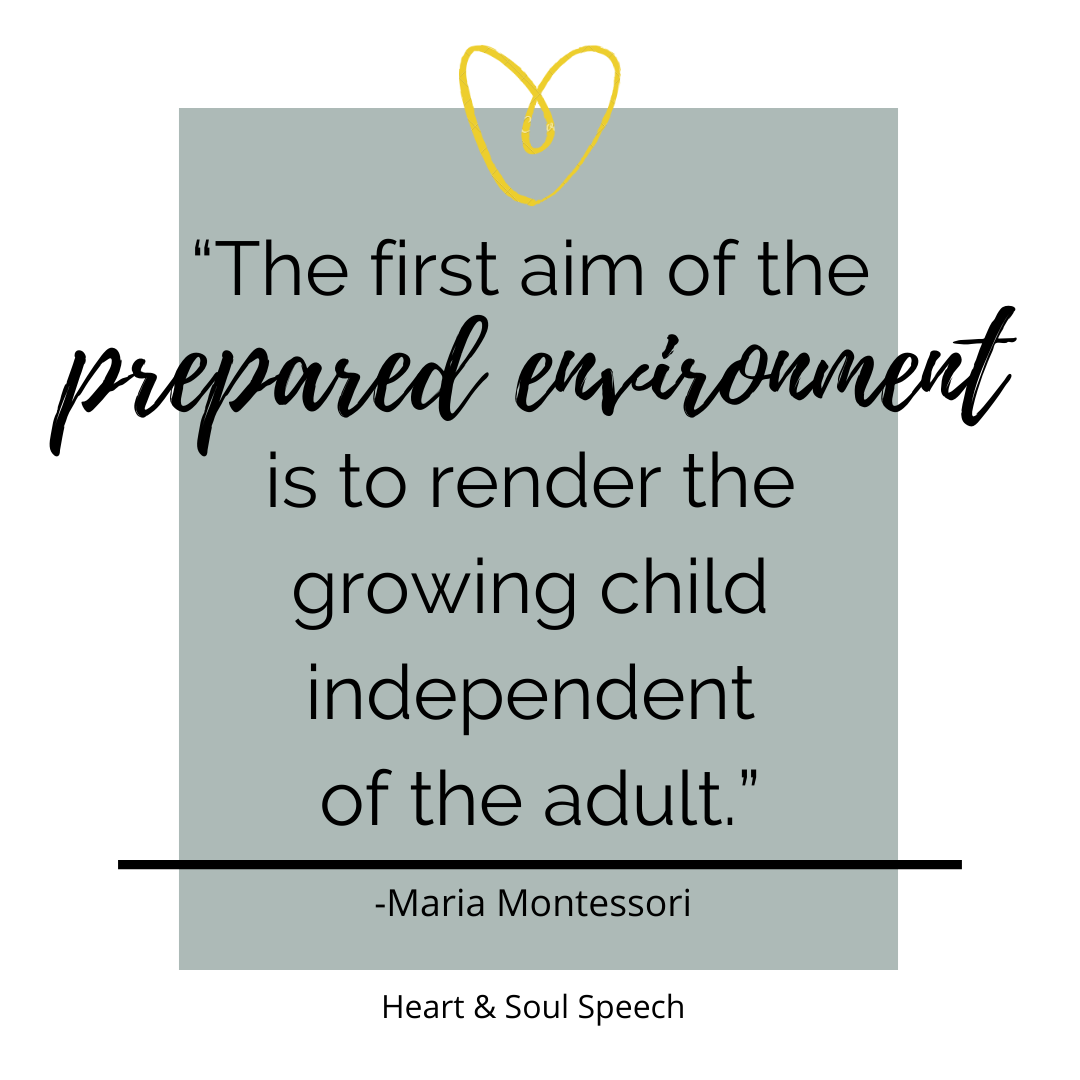As a speech-language pathologist serving families at home, a large part of my job is helping to create daily routines and physical spaces that enriches language development and positive interactions.
We know a child’s home environment has profound effects on development, learning, behavior, and well-being (1). Parents have the opportunity to prepare the home to promote healthy social-emotional development, language and literacy learning, and overall well-being. This can begin as early as infancy.

According to Maria Montessori, the idea of the prepared environment is to facilitate and maximize independent learning. Ideally, the calm and well-ordered setting allows children freedom to follow their interests and be included in their daily routines. Children learn self-discipline guided by the environment.
Environmental Factors that Affect Child Development
In addition to a child’s relationship with his parents, research indicates the physical environment plays a role in a child’s development. A “negative” home environment during a child’s first three years can lead to poorer language development and impaired cognitive development as a preschooler, decreased school readiness, increased aggression, anxiety, and depression in childhood (2-4).
Research also shows chaotic and crowded living spaces contribute to a child’s ability to learn and develop. Chronic noise exposure in childhood, such as background television or excessive screen use, noisy toys, or ambient sounds can interfere with reading acquisition (5). Additionally, inadequate space for play, exploration, and independent practice can decrease a child’s level of cooperative play, engagement with the environment, and parent-child interactions(6-7). It may also be true parents talk less with young children (8), use less complicated vocabulary, and simple sentence structures in more chaotic and crowded homes (9).
Children from homes with unpredictable and unstructured routines may have decreased academic achievement and socioemotional development, as well as behavior issues and symptoms of depression and anxiety (10-11). Furthermore, this has also been linked to poor sleep, deficits in self-regulation and learned helplessness (12-13), and decreased understanding of social cues (14).
Benefits of a Prepared Home Environment
A prepared home environment involves both consistent, predictable routines and organized, inviting spaces accessible to children throughout the home. This encourages children to participate in the home life, learning essential life skills for later independence. Other benefits include:
- Promotes positive relationship with child
- Increased cooperation and positive behavior
- Decreased parent stress
- Interactions
- Language development
- Calm and inviting spaces for learning
- Opportunities for life skill practice and independence
- Increased independence
- Peaceful, nurturing, and creative spaces for whole family
- Help promote child’s focus and concentration
- Allow child to fully absorb environment
- Build responsibility and appreciation for objects owned
- Respect their culture
- Opportunities for problem-solving and exploration
Just by making small modifications to your home, your children will play with more concentration, have more meaningful interactions, and feel valued during your daily routines.
Related Articles:
Independence & Natural Environment
References:
- Ferguson, K. T., Cassells, R. C., MacAllister, J. W., & Evans, G. W. (2013). The physical environment and child development: an international review. International journal of psychology, 48(4), 437–468. doi:10.1080/00207594.2013.804190
- Evans GW, Ricciuti HN, Hope S, et al. Crowding and cognitive development. The mediating role of maternal responsiveness among 36-month-old children. Environment and Behavior. 2010; 42(1): 135-148.
- Trentacosta CJ, Hyde, LW, Shaw DS, et al. The relations among cumulative risk, parenting, and behavior problems during early childhood. Journal of Child Psychology and Psychiatry. 2008; 49: 1211-1219.
- Vernon-Feagans L, Garrett-Peters P, Wil- loughby M, et al. Chaos, poverty, and parenting: Predictors of early language development. Early Childhood Research Quarterly. 2011.
- Evans GW. Child development and the physical environment. Annual Review of Psychology. 2006;57:423–451.
- Liddell C, Kruger P. Activity and social behavior in a South African township nursery: Some effects of crowding. Merrill-Palmer Quarterly. 1987;33:195–211.
- Liddell C, Kruger P. Activity and social behavior in a crowded South African township nursery: A follow-up study on the effects of crowding at home. Merrill-Palmer Quarterly.1989;35:209–226.
- Wachs TD, Bishry Z, Sobhy A, McCabe G, Galal O, Shaheen F. Relation of rearing environment to adaptive behavior of Egyptian toddlers. Child Development. 1993;64(2):586–604.
- Evans GW, Maxwell LE, Hart B. Parental language and verbal responsiveness to children in crowded homes. Developmental Psychology. 1999;35(4):1020–23.
- Ackerman BP, Brown ED. Physical and psychosocial turmoil in the home and cognitive development. Chaos and its influence on children’s development. American Psychological Association; 2010. pp. 35–48.
- Fiese BH, Winter MA. The dynamics of family chaos and its relation to children’s socio-emotional well being. Chaos and its influence on children’s development. American Psychological Association; 2010. pp. 49–66.
- Brody GH, Flor D, Gibson NM. Linking maternal efficacy beliefs, developmental goals, parenting practices, and child competence in rural single-parent African American families. Child Development. 1999;70:1197–1208.
- Evans GW, Marcynyszyn LA. Environmental justice, cumulative environmental risk, and health among low-and middle-income children in upstate New York. American Journal of Public Health. 2004;94:1942–1944.
- Dumas JE, Nissley J, Nordstrom A, Smith EP, Prinz RJ, Levine DW. Home chaos: Sociodemographic, parenting, interactional, and child correlates. Journal of Clinical Child and Adolescent Psychology. 2005;34:93–104.

2 Responses